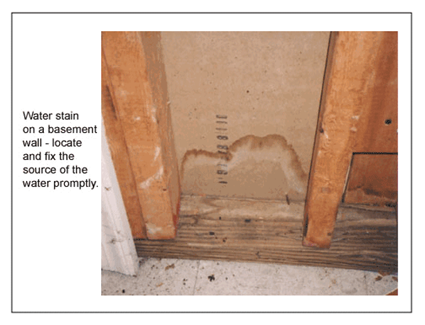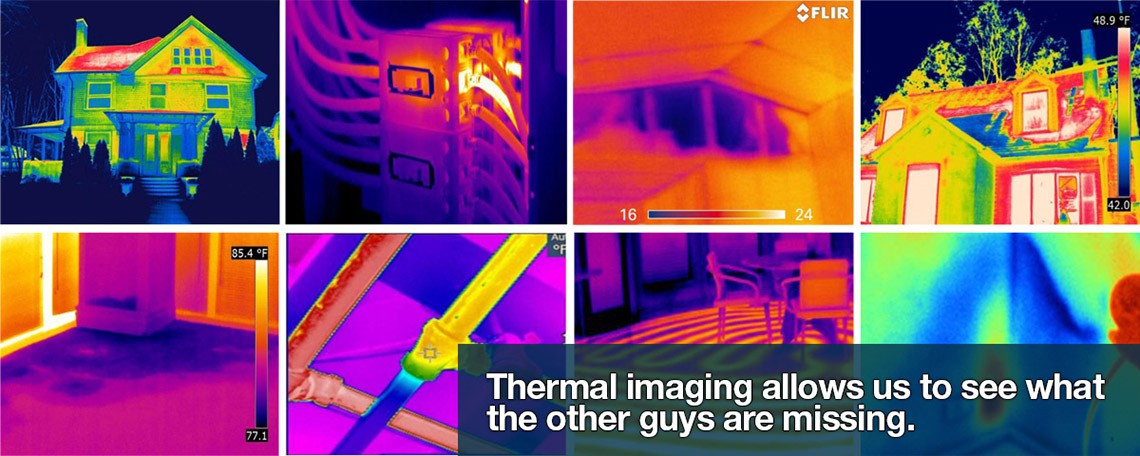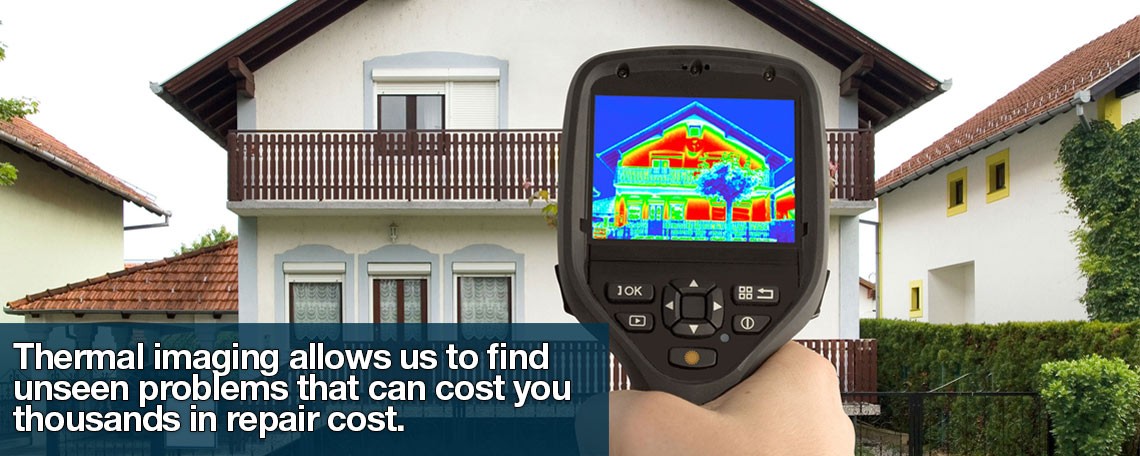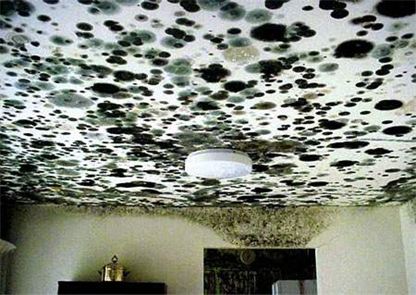Protect Your Home
The appropriate course of action is to always have a mold testing company do a mold test to formulate a base spore count in order to figure out if mold removal is needed. After your mold inspection has been finished, Stocks Home Inspection will be able to give you the information you need to get rid of it successfully. Very complete testing is needed in order to do this. A big mistake that a lot of people make is in believing that they can save money by doing things by themselves which can be very dangerous. The problem is that many forms of mold are invisible to the human eye, and special equipment is required. If you choose a certified mold specialist then they possess all of the gear needed for the testing. If you’re curious to know the mold inspection costs, then you should give us a call at 313-377-6967 immediately. On top of taking away the mold, this process will also help to boost the air quality of your home tremendously. In fact, after mold has been discovered in some homes, the residents have even mentioned that they didn’t even know what their home was expected to smell like without mold.
Ignoring A Black Mold Infestation Might Be A Really Bad Move
In Michigan, black mold presents a critical health risk. To make things a whole lot worse is the fact that without a comprehensive mold inspection it can be very difficult to find. Not everyone in Michigan will respond the same way upon contact with it, but allergic reactions are a common sign. Infants, children, older people, women that are pregnant, individuals with existing breathing conditions and immune deficient individuals are especially susceptible to black mold. And even though not all strands of mold will be black mold, they all are known to be allergens and can pose a significant health risk to those that come into contact with them. Unfortunately, mold problems can easily be misdiagnosed. A conventional misconception about black mold poisoning in Michigan is that a simple visit to the doctor is enough to identify it. This is completely wrong. Unless your doctor knows you have been subjected to mold, they often are not able to identify the problem. Overall there are roughly 25 symptoms that a person can have which is what makes detection so hard. It is very easy to mistake many of the signs or symptoms of black mold exposure for other ailments like the common cold or the flu. If you’re hoping that the symptoms of black mold will disappear, then you’ll be shocked to find out that they don’t. This is a stark contrast to the cold or flu which goes away after a while. In a lot of cases these signs or symptoms can even grow over time. The best thing for anyone to do if they have been subjected to black mold is to inform their pharmacist or doctor and request blood work. For complete black mold testing you can just call us at 313-377-6967.
The Most Widely Known Types of Black Mold
Mold can be found both outside and inside the house; through a number of air quality testing studies done in the state, it has been found that to some extent everyone has mold. The only difference is the degree and kind of mold that is found. To make things even more complicated is the truth that there are roughly 100,000 different mold varieties. 150 of these are oftentimes found throughout the state. All of these molds can cause allergic reactions and they include pathogenic (causes disease), toxigenic (inhalation can be poisonous) and carcinogenic (can cause cancer) mold species. Some of the symptoms of contact with mold include: bacterial infections, exhaustion, asthma, anxiety, respiratory problems, depression, sore burning eyes, memory lapses, flu-like symptoms, throat and lung irritation, skin problems, rashes and allergies as well. Stachybotrys, which is frequently known as black mold, is one of the most harmful types you can come across. Individuals that have already developed allergies to mold will find black mold to be even worse. It can cause many different symptoms, affecting the entire body including the immune, gastrointestinal, breathing and nervous systems, as well as the skin. If left untreated a person can even die from the symptoms of black mold.
Are You a Target of a Black Mold Infestation
You should pay attention to the fact that mold poisoning can happen to anyone regardless of age. Mold can be found in new buildings as well as older structures all across the country. It is not uncommon for many people to neglect mold testing and suffer the symptoms of poisoning for years without even being aware of what is going on. Some people may experience one or two symptoms, while others may experience and entire host of signs or symptoms. So also remember that just because you don’t experience all of the symptoms it does not mean that you don’t have a issue. For individuals that have questions about the mold testing cost then you can just contact Stocks Home Inspection at 313-377-6967
Mold Basics
- The key to mold control is moisture control.
- If mold is a problem in your home, you should clean up the mold promptly and fix the water problem.
- It is important to dry water-damaged areas and items within 24 to 48 hours to prevent mold growth.
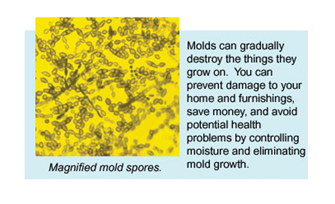 Why is mold growing in my home?
Why is mold growing in my home?
Molds are part of the natural environment. Outdoors, molds play a part in nature by breaking down dead organic matter, such as fallen leaves and dead trees. But indoors, mold growth should be avoided. Molds reproduce by means of tiny spores; the spores are invisible to the naked eye and float through outdoor and indoor air. Mold may begin growing indoors when mold spores land on surfaces that are wet. There are many types of mold, and none of them will grow without water or moisture
Can mold cause health problems?
Molds are usually not a problem indoors, unless mold spores land on a wet or damp spot and begin growing. Molds have the potential to cause health problems. Molds produce allergens (substances that can cause allergic reactions), irritants and, in some cases, potentially toxic substances (mycotoxins). Inhaling or touching mold or mold spores may cause allergic reactions in sensitive individuals. Allergic responses include hay fever-type symptoms, such as sneezing, runny nose, red eyes, and skin rash (dermatitis). Allergic reactions to mold are common. They can be immediate or delayed. Molds can also cause asthma attacks in people with asthma who are allergic to mold. In addition, mold exposure can irritate the eyes, skin, nose, throat and lungs of both mold-allergic and non-allergic people. Symptoms other than the allergic and irritant types are not commonly reported as a result of inhaling mold. Research on mold and health effects is ongoing. This article provides a brief overview; it does not describe all potential health effects related to mold exposure. For more detailed information, consult a health professional. You may also wish to consult your state or local health department.
How do I get rid of mold?
It is impossible to get rid of all mold and mold spores indoors. Some mold spores will be found floating through the air and in house dust. Mold spores will not grow if moisture is not present. Indoor mold growth can and should be prevented or controlled by controlling moisture indoors. If there is mold growth in your home, you must clean up the mold and fix the water problem. If you clean up the mold but don’t fix the water problem, then, most likely, the mold problem will recur.
Who should do the cleanup?
This depends on a number of factors. One consideration is the size of the mold problem. If the moldy area is less than about 10 square feet (less than roughly a 3-foot by 3-foot patch), in most cases, you can handle the job yourself, following the guidelines below.
- If there has been a lot of water damage, and/or mold growth covers more than 10 square feet, consult with an InterNACHI inspector.
- If you choose to hire a contractor (or other professional service provider) to do the cleanup, make sure the contractor has experience cleaning up mold. Check references and ask the contractor to follow the recommendations of the EPA, the guidelines of the American Conference of Governmental Industrial Hygienists (ACGIH), or other guidelines from professional or government organizations.
- Do not run the HVAC system if you know or suspect that it is contaminated with mold. This could spread mold throughout the building.
- If the water and/or mold damage was caused by sewage or other contaminated water, then call in a professional who has experience cleaning and fixing buildings damaged by contaminated water.
- If you have health concerns, consult a health professional before starting cleanup.
Tips and Techniques
The tips and techniques presented in this section will help you clean up your mold problem. Professional cleaners or remediators may use methods not covered here. Please note that mold may cause staining and cosmetic damage. It may not be possible to clean an item so that its original appearance is restored.
- Fix plumbing leaks and other water problems as soon as possible. Dry all items completely.
- Scrub mold off hard surfaces with detergent and water, and dry completely.
- Absorbent or porous materials, such as ceiling tiles and carpet, may have to be thrown away if they become moldy. Mold can grow on or fill in the empty spaces and crevices of porous materials, so the mold may be difficult or impossible to remove completely.
- Avoid exposing yourself or others to mold.
- Do not paint or caulk moldy surfaces.
- Clean up the mold and dry the surfaces before painting. Paint applied over moldy surfaces is likely to peel. If you are unsure about how to clean an item, or if the item is expensive or of sentimental value, you may wish to consult a specialist. Specialists in furniture repair and restoration, painting and art restoration and conservation, carpet and rug cleaning, water damage, and fire or water restoration are commonly listed in phone books. Be sure to ask for and check references. Look for specialists who are affiliated with professional organizations.
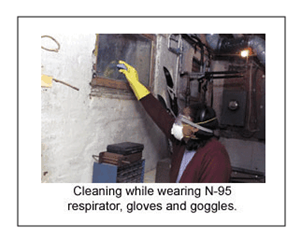 What to Wear When Cleaning Moldy Areas:
What to Wear When Cleaning Moldy Areas:
Avoid breathing in mold or mold spores. In order to limit your exposure to airborne mold, you may want to wear an N-95 respirator, available at many hardware stores and from companies that advertise on the Internet. (They cost about $12 to $25.) Some N-95 respirators resemble a paper dust mask with a nozzle on the front, and others are made primarily of plastic or rubber and have removable cartridges that trap and prevent most of the mold spores from entering. In order to be effective, the respirator or mask must fit properly, so carefully follow the instructions supplied with the respirator. Please note that the Occupational Safety and Health Administration (OSHA) requires that respirators fit properly (via fit testing) when used in an occupational setting.
- Wear gloves. Long gloves that extend to the middle of the forearm are recommended. When working with water and a mild detergent, ordinary household rubber gloves may be used. If you are using a disinfectant, a biocide such as chlorine bleach, or a strong cleaning solution, you should select gloves made from natural rubber, neoprene, nitrile, polyurethane or PVC. Avoid touching mold or moldy items with your bare hands.
- Wear goggles. Goggles that do not have ventilation holes are recommended. Avoid getting mold or mold spores in your eyes.
How do I know when the remediation or cleanup is finished?
You must have completely fixed the water or moisture problem before the cleanup or remediation can be considered finished, based on the following guidelines:
- You should have completed the mold removal. Visible mold and moldy odors should not be present. Please note that mold may cause staining and cosmetic damage.
- You should have revisited the site(s) shortly after cleanup, and it should show no signs of water damage or mold growth.
- People should have been able to occupy or re-occupy the area without health complaints or physical symptoms.
- Ultimately, this is a judgment call; there is no easy answer. If you have concerns or questions, be sure to ask your InterNACHI inspector during your next scheduled inspection.
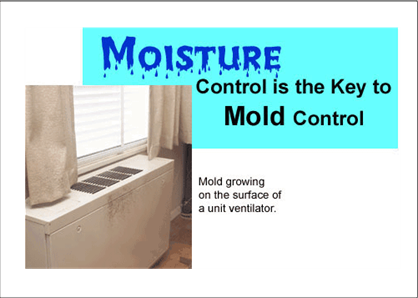
Moisture and Mold Prevention and Control Tips
- Moisture control is the key to mold control, so when water leaks or spills occur indoors, ACT QUICKLY. If wet or damp materials or areas are dried within 24 to 48 hours after a leak or spill happens, in most cases, mold will not grow.
- Clean and repair roof gutters regularly.
- Make sure the ground slopes away from the building’s foundation so that water does not enter or collect around the foundation.
- Keep air-conditioning drip pans clean and the drain lines unobstructed and flowing properly.
- Keep indoor humidity low. If possible, keep indoor humidity below 60% relative humidity (ideally, between 30% to 50%). Relative humidity can be measured with a moisture or humidity meter, which is a small, inexpensive instrument (from $10 to $50) that is available at many hardware stores.
- If you see condensation or moisture collecting on windows, walls or pipes, ACT QUICKLY to dry the wet surface and reduce the moisture/water source. Condensation can be a sign of high humidity.
Actions that will help to reduce humidity:
- Vent appliances that produce moisture, such as clothes dryers, stoves, and kerosene heaters, to the outdoors, where possible. (Combustion appliances, such as stoves and kerosene heaters, produce water vapor and will increase the humidity unless vented to the outside.)
- Use air conditioners and/or de-humidifiers when needed.
- Run the bathroom fan or open the window when showering. Use exhaust fans or open windows whenever cooking, running the dishwasher or dishwashing, etc.
Actions that will help prevent condensation:
- Reduce the humidity (see above).
- Increase ventilation and air movement by opening doors and/or windows, when practical. Use fans as needed.
- Cover cold surfaces, such as cold water pipes, with insulation.
- Increase air temperature.
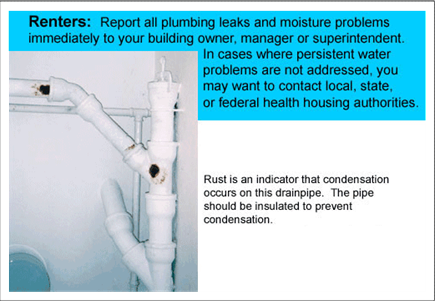
Testing or Sampling for Mold
Is sampling for mold needed? In most cases, if visible mold growth is present, sampling is unnecessary. Since no EPA or other federal limits have been set for mold or mold spores, sampling cannot be used to check a building’s compliance with federal mold standards. Surface sampling may be useful to determine if an area has been adequately cleaned or remediated. Sampling for mold should be conducted by professionals who have specific experience in designing mold sampling protocols, sampling methods, and interpreting results. Sample analysis should follow analytical methods recommended by the American Industrial Hygiene Association (AIHA), the American Conference of Governmental Industrial Hygienists (ACGIH), or other professional organizations.
Suspicion of Hidden Mold
You may suspect hidden mold if a building smells moldy but you cannot see the source, or if you know there has been water damage and residents are reporting health problems. Mold may be hidden in places such as the backside of dry wall, wallpaper or paneling, the top-side of ceiling tiles, or the underside of carpets and pads, etc. Other possible locations of hidden mold include areas inside walls around pipes (with leaking or condensing pipes), the surface of walls behind furniture (where condensation forms), inside ductwork, and in roof materials above ceiling tiles (due to roof leaks or insufficient insulation).
Investigating Hidden Mold Problems
Investigating hidden mold problems may be difficult and will require caution when the investigation involves disturbing potential sites of mold growth. For example, removal of wallpaper can lead to a massive release of spores if there is mold growing on the underside of the paper. If you believe that you may have a hidden mold problem, consider hiring an experienced professional for Mold testing.
Cleanup and Biocides
Biocides are substances that can destroy living organisms. The use of a chemical or biocide that kills organisms such as mold (chlorine bleach, for example) is not recommended as a routine practice during mold cleanup. There may be instances, however, when professional judgment may indicate its use (for example, when immune-compromised individuals are present). In most cases, it is not possible or desirable to sterilize an area; a background level of mold spores will remain, and these spores will not grow if the moisture problem has been resolved. If you choose to use disinfectants or biocides, always ventilate the area and exhaust the air to the outdoors. Never mix chlorine bleach with other cleaning solutions or detergents that contain ammonia because toxic fumes could be produced.
Please note: Dead mold may still cause allergic reactions in some people, so it is not enough to simply kill the mold; it must also be removed.
Ten Things You Should Know About Mold
- Potential health effects and symptoms associated with mold exposure include allergic reactions, asthma, and other respiratory complaints.
- There is no practical way to eliminate all mold and mold spores in the indoor environment; the way to control indoor mold growth is to control moisture.
- If mold is a problem in your home, you must clean up the mold and eliminate sources of moisture.
- Fix the source of the water problem or leak to prevent mold growth.
- Reduce indoor humidity (to 30% to 60%) to decrease mold growth by:
- a. venting bathrooms, dryers, and other moisture-generating sources to the outside; b. using air conditioners and de-humidifiers; c. increasing ventilation; and. using exhaust fans whenever cooking, dishwashing, and cleaning.
- Clean and dry any damp or wet building materials and furnishings within 24 to 48 hours to prevent mold growth.
- Clean mold off hard surfaces with water and detergent, and dry completely. Absorbent materials that are moldy (such as carpeting and ceiling tiles) may need to be replaced.
- Prevent condensation. Reduce the potential for condensation on cold surfaces (i.e., windows, piping, exterior walls, roof and floors) by adding insulation.
- In areas where there is a perpetual moisture problem, do not install carpeting.
- Molds can be found almost anywhere; they can grow on virtually any substance, provided moisture is present. There are molds that can grow on wood, paper, carpet, and foods.
